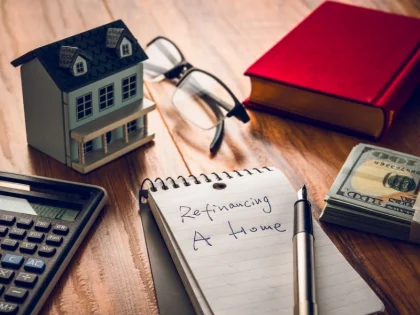Smart Mortgage Strategies For Refinancing
It's important to carefully consider your long-term financial objectives and existing loan terms before refinancing. Your home refinancing might yield significant benefits if you use a wise mortgage plan. Over the course of your loan, lower interest rates will save you money by reducing your monthly payments. Examine interest rate trends and make sure prepayment penalties are taken into account.
1. Lower Your Instalments Each Month

2. Combine your loans.
 You can opt to combine your debt when you refinance in order to assist with paying off high-interest loans and credit cards. Long-term, this method can save you money by lowering your monthly expenses.
It's crucial to remember, though, that debt consolidation does not always result in the elimination of existing debt. Instead, it helps you succeed financially by restructuring your debts into a single, manageable payment.
You must have enough equity in your house to be eligible for a mortgage refinance that consolidates your obligations. In order to approve a debt consolidation mortgage, lenders usually need to see at least 20% of the value of your house. To guarantee loan payback, you must additionally demonstrate consistent employment and income. To get the most out of your refinance mortgage, thoroughly consider your options and create a plan that suits your objectives. Subsequently, keep track of your progress by consistently computing your interest savings and acknowledging your achievements. You can create a refinance plan that maximizes your peace of mind by combining quantitative analysis with qualitative insights.
You can opt to combine your debt when you refinance in order to assist with paying off high-interest loans and credit cards. Long-term, this method can save you money by lowering your monthly expenses.
It's crucial to remember, though, that debt consolidation does not always result in the elimination of existing debt. Instead, it helps you succeed financially by restructuring your debts into a single, manageable payment.
You must have enough equity in your house to be eligible for a mortgage refinance that consolidates your obligations. In order to approve a debt consolidation mortgage, lenders usually need to see at least 20% of the value of your house. To guarantee loan payback, you must additionally demonstrate consistent employment and income. To get the most out of your refinance mortgage, thoroughly consider your options and create a plan that suits your objectives. Subsequently, keep track of your progress by consistently computing your interest savings and acknowledging your achievements. You can create a refinance plan that maximizes your peace of mind by combining quantitative analysis with qualitative insights.
3. Get Access to Your Home's Equity
 Through a cash-out refinance, a HELOC, or a home equity loan, homeowners can access the equity in their homes. Usually, homeowners utilize this equity to pay off high-interest debt, finance remodeling projects, or cover other costs.
Create a comprehensive mortgage strategy that considers all aspects of your finances to maximize refinancing. This entails knowing the fundamentals, evaluating your objectives, and contrasting lenders and lending choices.
When refinancing, it's important to understand your loan's goal, whether it's to lower your interest rate, shorten the loan term, or reduce monthly payments. In this way, you'll locate the ideal lenders and loans for your goals. Additionally, you must confirm that you have enough equity in your house and that your credit is satisfactory enough to be approved. Last but not least, you'll need to keep up with changes in the market, including mortgage rates.
Through a cash-out refinance, a HELOC, or a home equity loan, homeowners can access the equity in their homes. Usually, homeowners utilize this equity to pay off high-interest debt, finance remodeling projects, or cover other costs.
Create a comprehensive mortgage strategy that considers all aspects of your finances to maximize refinancing. This entails knowing the fundamentals, evaluating your objectives, and contrasting lenders and lending choices.
When refinancing, it's important to understand your loan's goal, whether it's to lower your interest rate, shorten the loan term, or reduce monthly payments. In this way, you'll locate the ideal lenders and loans for your goals. Additionally, you must confirm that you have enough equity in your house and that your credit is satisfactory enough to be approved. Last but not least, you'll need to keep up with changes in the market, including mortgage rates.
4. No Refinancing with Cash Out
 In order to obtain a cheaper interest rate, cut their monthly payments, or shorten their loan term, many borrowers decide to refinance. Even though these are significant factors, it's also critical to consider your long-term financial goals.
A no-cash-out refinance replaces your current loan with a new one, just like a regular mortgage. The distinction is that, unlike with a cash-out refinance, you are not turning any equity into cash.
Usually, your new mortgage will pay off your old one and borrow a sum that is at least as much as what you presently owe. At the end, the difference is returned to you as a lump payment. This is a popular choice for homeowners looking to switch lenders or consolidate their debts without touching their house's equity. Additionally, there are lenders that provide limited cash-out refinances. These loans replace your existing mortgage and allow you to access your home equity at a lower interest rate than a home equity loan or HELOC.
In order to obtain a cheaper interest rate, cut their monthly payments, or shorten their loan term, many borrowers decide to refinance. Even though these are significant factors, it's also critical to consider your long-term financial goals.
A no-cash-out refinance replaces your current loan with a new one, just like a regular mortgage. The distinction is that, unlike with a cash-out refinance, you are not turning any equity into cash.
Usually, your new mortgage will pay off your old one and borrow a sum that is at least as much as what you presently owe. At the end, the difference is returned to you as a lump payment. This is a popular choice for homeowners looking to switch lenders or consolidate their debts without touching their house's equity. Additionally, there are lenders that provide limited cash-out refinances. These loans replace your existing mortgage and allow you to access your home equity at a lower interest rate than a home equity loan or HELOC.







